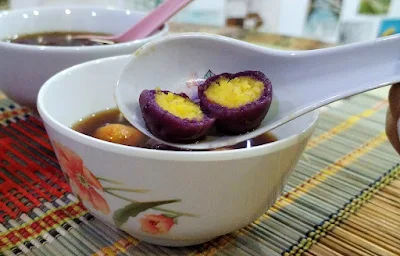Sweet Potato Mochi Tangyuan (番薯奶黄糯米糍汤圆)
These
glutinous rice balls are distinctive from others since they are made with
flavorful sweet potatoes. The custard filling is wrapped in a glutinous rice
ball, which is not only distinctive in form but also incredibly eye-catching.
Glutinous
rice balls are made of glutinous rice and have a high viscosity, which makes
them difficult to digest for some people. This mochi tangyuan is using more sweet
potatoes and less glutinous rice flour.
This
recipe is something like making mochi. Making this mochi tangyuan with the kids is a
delightful project since you may mould and fill the rice balls with your own
paste. I combined mashed orange, purple, and yellow sweet potatoes with
glutinous flour to make the rice ball. Different varieties of potatoes absorb
flour and water at varying rates. The yellow potatoes require extra water or flour
to make a proper dough because they are fairly dry after steaming. I need to
use more flour and less water because the texture of orange and purple potatoes
is moister and softer after steaming.
The common practice is to add a
little water if the dough feels too dry. In fact, holding back a little of the
water from the recipe, and adding it in incrementally, going by feel rather
than measurement, is the preferred way to get a perfect dough.
Custard is a kind of filling that
child like very much, and my children like to eat them very much. So, I often make
some custard fillings at home. It is very convenient and delicious. Of course,
you can use any filling that you like.
INGREDIENTS
(For
glutinous rice balls)
150g
glutinous rice flour
80g
orange or yellow or purple sweet potatoes
1
tbsp sugar
1
tsp cooking oil
50ml
water
(For
custard)
60g custard powder
40g milk powder
45g sugar
100ml coconut milk
80ml milk
1 egg (beaten)
25ml cooking oil or melted butter
(Sugar water)
1000ml water
2 pandan leaves, knotted
10g sliced ginger
50g palm sugar
METHODS (for the filling)
1. Combine dry ingredients (custard
powder, sugar, and milk powder). Add in coconut milk, milk, and beaten eggs.
Mixed it well until it is incorporated.
2. Add cooking oil. Mixed well again.
There will be a lot of little lumps in the mixture, sieved it through a
strainer to get a smooth mixture.
3. Transfer to 2 lightly greased
heatproof dishes and steamed them at HIGH heat for 10 minutes.
4. Remove the custard from the
steamer, let it cool for about 10 minutes, and scrape off the custard dough
from the dish. Put it on the table and knead the custard until it becomes a
smooth paste. The custard is much easier to work with while it is still warm.
If you let it cool completely, it takes much longer to knead it to smooth. You
can also make the custard one day ahead and leave it in the fridge overnight
5. Roll the custard into a ball about
2cm in size and set aside for later use.
METHODS (For glutinous rice balls)
1. Peel and cut orange sweet potatoes
into small pieces, and steam for -10 minutes until soft.
2. Mashed the sweet potatoes in a
mixing bowl, add half of the glutinous rice flour (according to the water
content of sweet potatoes, add a little flour), then add oil and sugar.
3. Knead the dough with your hands
until smooth and not sticky, then divided the dough into balls.
4. Put the custard into the glutinous
rice and repeat the steps until the custard and glutinous rice dough is used
up.
5. In a pot filled with water, pandan
leaves, sliced ginger, and palm sugar. Bring it to a boil, turn it to low heat
and let it simmer for 20-30 minutes.
6. Put the glutinous rice balls into
the pot and give it a stir to prevent the rice balls from sticking to the
bottom of the pot. Cook
the rice balls until they begin to float to the top of the pot. Serve hot and
enjoy!!






Comments
Post a Comment